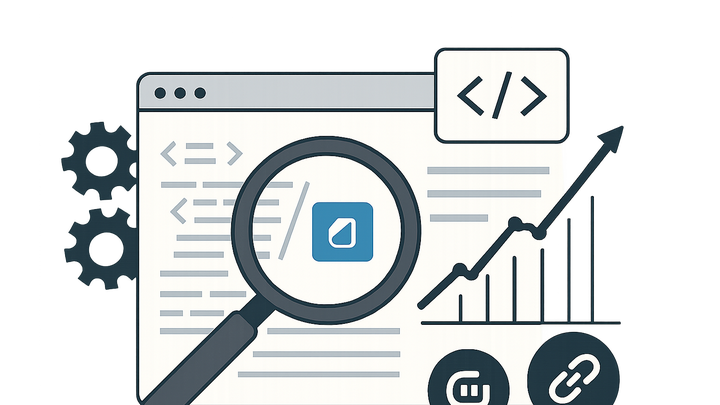Published on 2025-06-29T20:13:18Z
What is SEO (Search Engine Optimization)?
Search Engine Optimization (SEO) is the practice of improving a website’s structure, content, and technical setup to increase its visibility on search engine results pages (SERPs). By targeting relevant keywords and optimizing on-page and off-page elements, SEO helps attract qualified organic traffic without relying solely on paid advertising. Effective SEO enhances user experience by aligning site architecture, page load speed, and mobile-friendliness with search engine best practices. In the context of conversion rate optimization (CRO) and user experience (UX), SEO serves as the foundation for driving high-intent visitors who are more likely to engage and convert. Tools like Prevue.me offer actionable critiques on SEO factors, alongside UX, accessibility, and CRO recommendations to help maximize lead generation. Continuous monitoring and iterative improvements ensure that SEO strategies adapt to algorithm updates and evolving user behaviors.
Seo (search engine optimization)
SEO is the practice of optimizing websites to rank higher in search engine results and attract organic traffic.
Overview of SEO and Its Importance
This section explains what SEO is, why it’s critical for websites aiming to increase visibility, organic traffic, and support CRO/UX strategies.
-
Definition of seo
Clarifies what Search Engine Optimization entails and how it fits within digital marketing.
-
Why seo matters
Discusses the benefits of SEO, including cost-effective traffic, improved user trust, and synergy with CRO.
-
Seo’s role in cro and ux
Explores how SEO supports conversion rate optimization and enhances user experience on websites.
Core Components of SEO
An in-depth look at the building blocks of SEO, covering on-page, off-page, and technical factors.
-
On-page seo
Involves optimizing individual webpages to rank higher and earn more relevant traffic in search engines.
- Meta tags and titles:
Crafting descriptive and keyword-rich title tags and meta descriptions to improve click-through rates.
- Header tags (h1, h2...):
Using header tags to structure content and signal importance of keywords to search engines.
- Content quality:
Producing valuable, relevant, and well-structured content that satisfies user intent.
- Meta tags and titles:
-
Technical seo
Ensures that website infrastructure and code are optimized for search engine crawling and indexing.
- Site speed:
Optimizing load times to meet user expectations and search engine benchmarks.
- Mobile-friendliness:
Ensuring responsive design and usability on mobile devices.
- Structured data:
Implementing schema markup to help search engines understand content context.
- Site speed:
-
Off-page seo
Building a website’s authority through external signals like backlinks and social engagement.
- Backlinks:
Earned links from reputable sites that signal trust and authority to search engines.
- Social signals:
Engagement metrics from social platforms that can indirectly influence SEO.
- Local seo:
Optimizing for location-based searches with Google My Business and local citations.
- Backlinks:
Best Practices for SEO Optimization
Actionable strategies and workflows for implementing effective SEO campaigns.
-
Keyword research and targeting
Identifying high-value search terms based on volume, intent, and competition.
- Using research tools:
Leveraging tools like SEMrush, Ahrefs, and Google Keyword Planner to find keywords.
- Long-tail keywords:
Focusing on longer, specific phrases to capture niche audiences with clear intent.
- Using research tools:
-
Content strategy and e-a-t
Developing content plans that demonstrate Expertise, Authoritativeness, and Trustworthiness.
- Topic clusters:
Organizing content into clusters around pillar pages for better topical authority.
- Quality over quantity:
Prioritizing in-depth, accurate, and user-focused content over frequent but shallow posts.
- Topic clusters:
-
Technical audits and monitoring
Regularly assessing site health and performance to catch and fix SEO issues early.
- Using prevue.me:
Utilizing prevue.me crawls to identify technical errors, accessibility gaps, and SEO opportunities.
- Search console insights:
Monitoring performance metrics, indexing status, and crawl errors in Google Search Console.
- Using prevue.me:
Integrating SEO with CRO and UX
Best practices for aligning SEO strategies with conversion rate optimization and user experience improvements.
-
Ux and core web vitals
Ensuring site performance factors like LCP, FID, and CLS meet SEO and UX standards.
- Largest contentful paint (lcp):
Optimizing server response times and asset loading for faster initial rendering.
- First input delay (fid):
Minimizing JavaScript blocking to speed up interactivity.
- Cumulative layout shift (cls):
Preventing unexpected layout shifts to improve perceived stability.
- Largest contentful paint (lcp):
-
Data-driven cro for seo traffic
Using A/B testing, heatmaps, and user feedback to convert organic visitors into leads.
- Landing page optimization:
Aligning page headlines, CTAs, and forms with user intent and search queries.
- Behavioral analytics:
Leveraging tools like Hotjar and Google Analytics to understand user journeys.
- Landing page optimization:
Tools and Resources
Key SaaS platforms and free tools to support ongoing SEO efforts.
-
Prevue.me
Provides comprehensive website audits across SEO, UX, accessibility, and CRO with prioritized, actionable insights.
- Automated seo reports:
Generates prioritized SEO issues and recommendations in an easy-to-understand format.
- Holistic critiques:
Combines SEO with UX, accessibility, and conversion insights for well-rounded optimization.
- Automated seo reports:
-
Google search console
A free tool to monitor indexing status, search queries, and technical issues.
- Performance report:
Analyzes clicks, impressions, CTR, and average positions for queries.
- Coverage report:
Shows indexing status and errors for URLs.
- Url inspection:
Allows testing of live URLs for indexing and optimization issues.
- Performance report:
-
Sem tools (semrush, ahrefs)
Comprehensive platforms for keyword research, backlink analysis, and competitive audits.
- Keyword analytics:
Tracks keyword rankings and difficulty.
- Backlink audits:
Evaluates link profiles to find toxic or valuable backlinks.
- Keyword analytics:
